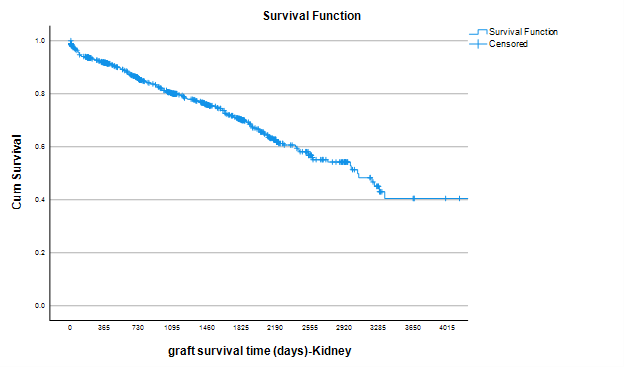Characteristics, demographics and outcomes of kidney transplant recipients with extreme dialysis vintage > 10 years. A national UNOS database review 2000-2021
Asif Sharfuddin1, Muhammad S Yaqub1, Oluwafisayo Adebiyi1, Tim E Taber1, Dennis P Mishler1, Muhammad Y Jan1.
1Medicine/Nephrology, Indiana University, Indianapolis, IN, United States
Introduction: Prolonged dialysis times (DT) have been associated with inferior outcomes. Nevertheless, rarely suitable candidates with extreme dialysis vintage are transplanted. We aimed to review the characteristics, demographics and outcomes of such patients.
Methods: We used United Network for Organ Sharing registry data to assess outcomes for patients who were on dialytic therapy for a minimum of 10 years, who received a kidney alone transplant from Jan 1 2000 – Dec 31 2021. Pediatrics, multi-organ transplants and those without a confirmed dialysis start date were excluded.
Results: During the study period, a total of 361,029 kidney alone transplants were performed, of which 70.3% were patients who were on dialysis at the time of transplant. Out of the 253,841 dialysis patients, transplanted, 962 (0.37%) patients met our criteria. The majority of transplants (78.7%) in these 962 cases were performed after Dec, 2014 when the new KAS allocation which credits waitlist time from chronic dialysis initiation was implemented. There was no difference in graft survival for race, gender, but DM and DGF were independant predictors of inferior survival (p<0.05).
| Mean Age at Time of Transplant (yrs) | 49.9+/-10.5 (18-75) |
| Race (AA/Whites/Hispanics) (%) | 41.9 / 21.1 / 24.7 |
| Gender (M/F) (%) | 53.5 / 38.5 |
| Re-Transplants (%) | 38.5 |
| Deceased Donor / Living Donor Transplants (%) | 97.3 / 2.7 |
| Etiology of ESRD (DM/HTN/Other) (%) | 24.8 / 20.7 / 54.5 |
| CPRA (0-20, 20-80, 80-97, 98-100) (%) | 31.8 / 19.6 / 12.7 / 35.9 |
| Zero Mismatch (%) | 5.7 |
| PVD (%) | 5.2 |
| Median Dialysis Time (yrs) | 12.4 (10-32) |
| Dialysis Time (10-15yrs / 15-20yrs / > 20 yrs) (%) | 76.7 / 16.4 / 6.8 |
| Mean Donor Age (yrs) | 36.4 +/-13.9 (1-69) |
| Donor Race (Whites/AA/Hispanics) (%) | 52 / 18.6 / 22.6 |
| Donor Gender (M/F) (%) | 61.9 / 38.1 |
| DCD (%) | 16.4 |
| ECD (%) | 6.3 |
| KDPI Median | 38 |
| KDPI > 85 (%) | 1.8 |
| Donor HTN / DM (%) | 21.5 / 4.3 |
| Median Cold Ischemia Time (hrs) | 16 |
| Kidneys Pumped (%) | 34.5 |
| Donor PHS Increased Risk (%) | 15 |
| DGF (%) | 34.7 |
| Acute Rejection within 1 year (%) | 9.8 |
| Mean Length of Stay (days) | 7.7+/- 9.1 |
| Patient Death within 30 days n (%) | 8 (0.8) |
| Graft Failure Within 30 days n (%) | 25 (2.5) |
| Graft Survival (%) 1yr / 3yr / 5yr / 10 yr | 92 / 80 / 70 / 41 |
| Patient Survival (%) 1yr / 3yr/ 5yr / 10yr | 96 / 88 / 80 / 50 |

Conclusions: The present study is the first to look at the granular details of this unique group of patients who receive a transplant after a minimum of 10 years of dialysis. Although outcomes may be somewhat inferior to standard outcomes of patients with shorter dialysis times, carefully selected candidates can still have reasonable successful outcomes.

right-click to download
